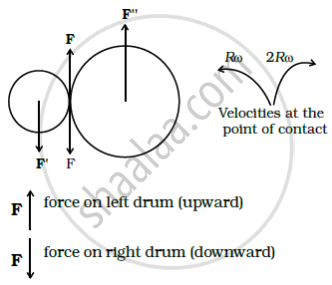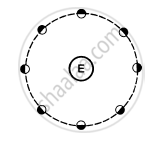Advertisements
Advertisements
प्रश्न
Two cylindrical hollow drums of radii R and 2R, and of a common height h, are rotating with angular velocities ω(anti-clockwise) and ω(clockwise), respectively. Their axes, fixed are parallel and in a horizontal plane separated by (3R + δ). They are now brought in contact (δ → 0).
- Show the frictional forces just after contact.
- Identify forces and torques external to the system just after contact.
- What would be the ratio of final angular velocities when friction ceases?
उत्तर
a. The frictional forces acting between two cylindrical hollow drums are shown in the diagram below.
Force F upward shows the friction force on the left drum.
Force F downward shows the friction force on the right drum.
b. F' = F = F” where F and F” are external forces through support.
⇒ Fnet = 0 ......(one each cylinder)
Net external torque to the system about any axis = F × 3R, anticlockwise

c. Let ω1 and ω2 be the final angular velocities of smaller and bigger drums respectively (anticlockwise and clockwise respectively).
Finally, there will be no friction. When friction ceases at the point of contact, then both drums have an equal linear velocity at that point.
VA = VB
Hence, Rω1 = 2Rω2 ⇒ `ω_1/ω_2` = 2
Important point: Friction force just opposes the relative motion of the point of contact at any instant. So, we should be very careful while indicating the direction of frictional forces.
APPEARS IN
संबंधित प्रश्न
The moon rotates about the earth in such a way that only one hemisphere of the moon faces the earth (see the following figure). Can we ever see the "other face" of the moon from the earth? Can a person on the moon ever see all the faces of the earth?

A sphere rolls on a horizontal surface. If there any point of the sphere which has a vertical velocity?
The angular velocity of the engine (and hence of the wheel) of a scooter is proportional to the petrol input per second. The scooter is moving on a frictionless road with uniform velocity. If the petrol input is increased by 10%, the linear velocity of the scooter is increased by ___________ .
A sphere is rolled on a rough horizontal surface. If gradually slows down and stops. The force of friction tries to
(a) decrease the linear velocity
(b) increase the angular velocity
(c) increase the linear momentum
(d) decrease the angular velocity.
A disc of radius 10 cm is rotating about its axis at an angular speed of 20 rad/s. Find the linear speed of a point on the rim.
A block hangs from a string wrapped on a disc of radius 20 cm free to rotate about its axis which is fixed in a horizontal position. If the angular speed of the disc is 10 rad/s at some instant, with what speed is the block going down at that instant?
A wheel rotating at a speed of 600 rpm (revolutions per minute) about its axis is brought to rest by applying a constant torque for 10 seconds. Find the angular deceleration and the angular velocity 5 seconds after the application of the torque.
A wheel of mass 10 kg and radius 20 cm is rotating at an angular speed of 100 rev/min when the motor is turned off. Neglecting the friction at the axle, calculate the force that must be applied tangentially to the wheel to bring it to rest in 10 revolutions.
A boy is standing on a platform which is free to rotate about its axis. The boy holds an open umbrella in his hands. The axis of the umbrella coincides with that of the platform. The moment of inertia of "the platform plus the boy system" is 3⋅0 × 10−3 kg-m2 and that of the umbrella is 2⋅0 × 10−3 kg-m2. The boy starts spinning the umbrella about the axis at an angular speed of 2⋅0 rev/s with respect to himself. Find the angular velocity imparted to the platform.
A ball falls on the ground from a height of 2.0 m and rebounds up to a height of 1.5 m. Find the coefficient of restitution.
